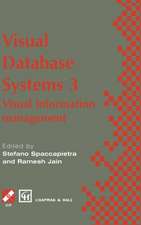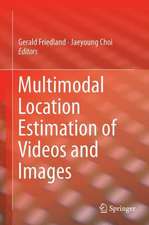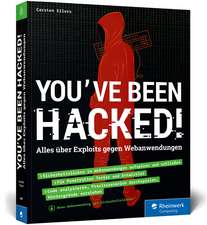Multimedia Computing
Autor Gerald Friedland, Ramesh Jainen Limba Engleză Hardback – 27 iul 2014
Preț: 531.72 lei
Preț vechi: 664.65 lei
-20% Nou
Puncte Express: 798
Preț estimativ în valută:
101.76€ • 105.84$ • 84.01£
101.76€ • 105.84$ • 84.01£
Carte tipărită la comandă
Livrare economică 15-29 aprilie
Preluare comenzi: 021 569.72.76
Specificații
ISBN-13: 9780521764513
ISBN-10: 0521764513
Pagini: 368
Ilustrații: 111 b/w illus. 9 colour illus. 3 tables 233 exercises
Dimensiuni: 182 x 261 x 25 mm
Greutate: 0.91 kg
Ediția:New.
Editura: Cambridge University Press
Colecția Cambridge University Press
Locul publicării:New York, United States
ISBN-10: 0521764513
Pagini: 368
Ilustrații: 111 b/w illus. 9 colour illus. 3 tables 233 exercises
Dimensiuni: 182 x 261 x 25 mm
Greutate: 0.91 kg
Ediția:New.
Editura: Cambridge University Press
Colecția Cambridge University Press
Locul publicării:New York, United States
Cuprins
1. Introduction; 2. Multimedia: a definition; 3. Elements of multimedia computing; 4. Introduction to sensors; 5. Sound; 6. Light; 7. Multimedia documents; 8. Multimodal integration and synchronization; 9. Multimedia systems; 10. The human factor; 11. Fundamentals of compression; 12. Lossy compression; 13. Advanced perceptual compression; 14. Speech compression; 15. Multimedia information retrieval; 16. Signal processing primer; 17. Multimedia content analysis; 18. Content analysis systems; 19. Content and context; 20. Future topics.
Recenzii
'This book fills a critical need in multimedia computing by offering a comprehensive, authoritative, and holistic review of key principles, state-of-the-art technologies, and open issues in this vibrant field. Authored by two renowned pioneers and educators, it will be a wonderful book for students and anyone interested in learning more about multimedia.' Shih-Fu Chang, Columbia University
'The multimedia field needed a textbook, and it is finally here. This is a comprehensive textbook covering a diverse set of topics in modern multimedia. Each chapter is very accessible; this book will be an excellent resource for beginning graduate students and for practitioners.' Mubarak Shah, University of Central Florida
'This is the long-awaited textbook on multimedia. The authors, both senior members of the multimedia community, have managed to produce a book that is useful not only to students and practitioners but also to many of us in the field. The book is comprehensive in its coverage of the subject, and it is structured in an easy-to-read way. I particularly like the fact that the exercises are meant to solicit the readers to think beyond the actual content of the book.' Nicu Sebe, University of Trento
'Teaching multimedia is challenging because it encompasses concepts and technology from many areas, including human perception, digital representation of continuous and discrete data and behavior, synchronization in space and time, and distributed real-time software/hardware systems. Applications range from multimedia authoring, analysis, and retrieval to interactive entertainment and distributed collaboration. Multimedia Computing covers a wide range of material suitable for a one- to two-semester introduction to multimedia. It covers the fundamentals of human perception that produce multimedia experiences through the systems and applications used to produce these experiences. Friedland and Jain do an excellent job of presenting enough details and enough guidance to further sources for students to understand the scope of the field and to learn more about topics of interest.' Lawrence A. Rowe, Professor Emeritus, University of California, Berkeley
'Multimedia Computing is indeed an excellent resource - a one-stop resource - for students, young researchers, and professionals. The authors have provided the basics from the physics concepts of sound and light to user interface design for multimedia systems. A must-read book.' B. Prabhakaran, University of Texas, Dallas
'The multimedia field needed a textbook, and it is finally here. This is a comprehensive textbook covering a diverse set of topics in modern multimedia. Each chapter is very accessible; this book will be an excellent resource for beginning graduate students and for practitioners.' Mubarak Shah, University of Central Florida
'This is the long-awaited textbook on multimedia. The authors, both senior members of the multimedia community, have managed to produce a book that is useful not only to students and practitioners but also to many of us in the field. The book is comprehensive in its coverage of the subject, and it is structured in an easy-to-read way. I particularly like the fact that the exercises are meant to solicit the readers to think beyond the actual content of the book.' Nicu Sebe, University of Trento
'Teaching multimedia is challenging because it encompasses concepts and technology from many areas, including human perception, digital representation of continuous and discrete data and behavior, synchronization in space and time, and distributed real-time software/hardware systems. Applications range from multimedia authoring, analysis, and retrieval to interactive entertainment and distributed collaboration. Multimedia Computing covers a wide range of material suitable for a one- to two-semester introduction to multimedia. It covers the fundamentals of human perception that produce multimedia experiences through the systems and applications used to produce these experiences. Friedland and Jain do an excellent job of presenting enough details and enough guidance to further sources for students to understand the scope of the field and to learn more about topics of interest.' Lawrence A. Rowe, Professor Emeritus, University of California, Berkeley
'Multimedia Computing is indeed an excellent resource - a one-stop resource - for students, young researchers, and professionals. The authors have provided the basics from the physics concepts of sound and light to user interface design for multimedia systems. A must-read book.' B. Prabhakaran, University of Texas, Dallas
Notă biografică
Descriere
This innovative textbook presents an experiential, holistic approach to multimedia computing along with practical algorithms.























